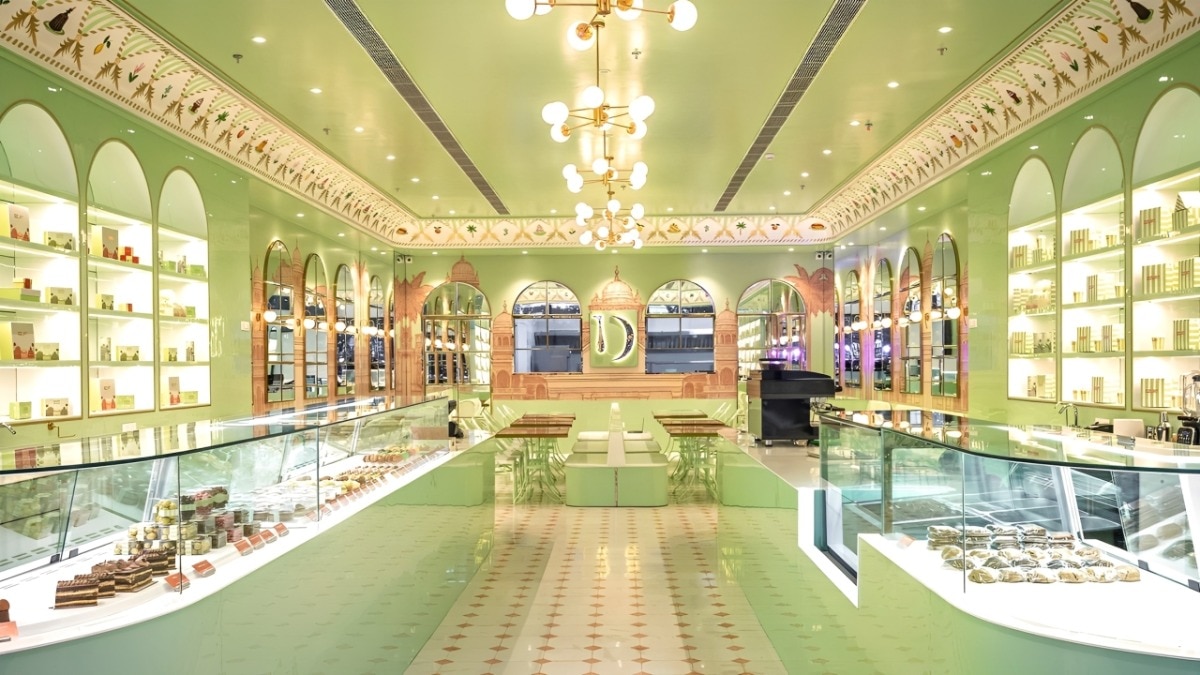The new patisserie rewriting Jaipur’s flavour playbook with nostalgia-led desserts
From ghewar tarts to fruity gelatos, chef Tejasvi Chandela is transforming the way India tastes dessert.

Jaipur’s dessert scene just got a serious glow-up with chef Tejasvi Chandela’s Dzurt. With a brand new store at Horizon Tower, this part patisserie, part creamery, and café in one, is blending thoughtful flavours with sharp technique and a design sensibility that feels both familiar and fresh.
Designed by Marie-Anne Oudejans, the space reads like a modern tribute to Jaipur: warm, detailed, and quietly cosmopolitan. It’s the kind of place you walk into for a quick bite and end up staying because everything, from the scent of butter to the pastel walls, feels quietly joyful.
At the centre of it all is chef Chandela, who has built a dessert world where nostalgia is beautifully reimagined. Yes, she can turn ghewar into a tart or fold childhood comfort into gelato without losing the emotion behind it. Her approach is playful yet precise, modern but deeply rooted in memory and craft.
We caught up with her to talk about finding the balance between tradition and experimentation, how she decides which trends to skip, and what Dzurt’s next chapter means for a country that is thinking about dessert in exciting new ways.
Cosmopolitan India: Dzurt has redefined how Jaipur experiences dessert. What do you think makes India’s dessert culture so exciting right now?
Tejassvi Chandela: India is at a beautiful intersection of nostalgia and experimentation. We’re a country with centuries of dessert traditions, but we’re also a generation that’s curious, well-travelled, and unafraid to try new things. What excites me most is that Indian diners today value both memory and modernity—they’ll enjoy a classic rasmalai with the same enthusiasm as a plated dessert with kaffir lime or miso. That openness gives chefs like me the freedom to push boundaries without losing the emotional essence of Indian desserts.
CI: You’ve created everything from ghewar tarts to kulfi falooda gelato. What draws you to reimagine nostalgic Indian flavours in a modern way?
TC: I grew up around flavours that felt like home—ghee, cardamom, rose, saffron. Reimagining them is my way of honouring those memories while speaking the language of contemporary pastry. I love the challenge of taking something familiar and giving it a new form, new texture, or new temperature. When someone says, “This tastes like childhood… but better,” that is the biggest compliment. It means I’ve bridged sentiment with craft.
CI: Dessert trends change fast—it's minimalist cakes one season, and nostalgic treats the next. How do you decide which trends to play with and which to skip?
TC: I chase flavour, not trends. If a trend genuinely enhances taste or technique, I’ll explore it. But if it only looks good on Instagram and doesn’t elevate the eating experience, I step back. At Dzurt, we’ve built a philosophy around balance—nothing too sweet, nothing too flashy without purpose. So the question I always ask is: Will this still taste good five years from now? If the answer is yes, we go for it.
CI: As someone who trained in Paris and Barcelona, what’s one global pastry philosophy you’ve adapted to fit an Indian palate?
TC: Restraint. French pastry taught me the power of balance—how acidity cuts sweetness, how texture carries flavour, how less can truly be more. When I create for an Indian audience, I keep that philosophy at the centre. Indian palates are diverse, but universally, we appreciate harmony. So even if I’m working with inherently rich ingredients like rabri, pistachio, or ghee, the goal is always to create structure and lightness, not heaviness.
CI: Dzurt is known for being “flavour-first.” What’s a recent creation that completely surprised you—or your guests?
TC: There are two, actually. The first is our Jaipur ghewar tart. It started as a playful experiment—taking a festive staple and giving it a new identity. We soak the ghewar in orange juice and sugar syrup so it stays light and aromatic, then pipe it with pistachio ganache and finish it with tiny orange juice caviar pearls. Guests expected something heavy, but the freshness and finesse really surprised them. It’s become one of those desserts that make people pause mid-bite.
The other is our apple crumble gelato. It’s everything people love about a warm apple crumble, reimagined in a cold, velvety form. The balance of stewed apples, cinnamon, and real crumble mixed into the gelato has created this nostalgic, yet new experience that even I didn’t anticipate would resonate so deeply. Watching guests’ reactions has been the best part.
CI: You’ve built Dzurt from Jaipur into a brand that feels world-class yet deeply rooted in local culture. What does this next chapter mean for you—and for India’s dessert scene?
TC: This next chapter is about scale with soul. Jaipur has shaped my sensibilities—its craft, colours, and generosity are woven into Dzurt’s identity. As we grow, I want to take that essence to more cities, more collaborations, and more formats—from gelato to plated desserts to large-scale wedding experiences. India’s dessert landscape is evolving rapidly, and I hope Dzurt becomes a reminder that you can be both hyper-local in emotion and globally refined in technique.
CI: If Dzurt were a person, how would you describe her?
TC: She would be warm, intuitive, and quietly confident—the kind of woman who pays attention to the little details because she knows that’s where the magic lives. She’s rooted in her culture but never afraid to experiment, a gentle mix of elegance and playfulness. She walks into a room with charm, makes people feel cared for, and believes that flavour speaks louder than flair. She’s timeless, but never boring. Wholesome at heart with a streak of whimsy.
All images: The brand
Also read: Sinfully indulgent desserts to satisfy your sweet cravings on chilly days
Also read: Check out Mumbai’s best dessert spots for the perfect eggless indulgence
more from Life

Why bloomscrolling is the internet’s new antidote to endless-feed fatigue

Why Gen Z is swapping the hustle culture for slow mornings instead

Low-maintenance friendships are on the rise and here's why we’re apart but closer than ever

The surprising truths about Gen Z—the world’s favourite punching bag

‘Airport divorce’ is the new travel trend couples are taking off with—and here's why it makes total sense

Gen Z terms are hot, but here are basic words that say “manners”!

What are "better husband retreats"?

7 everyday skincare habits you’re overlooking that make all the difference

Is digital culture making rejection feel worse for young people?

The ‘robe theory’ is here to remind you that 'rest' is the new 'rich'
